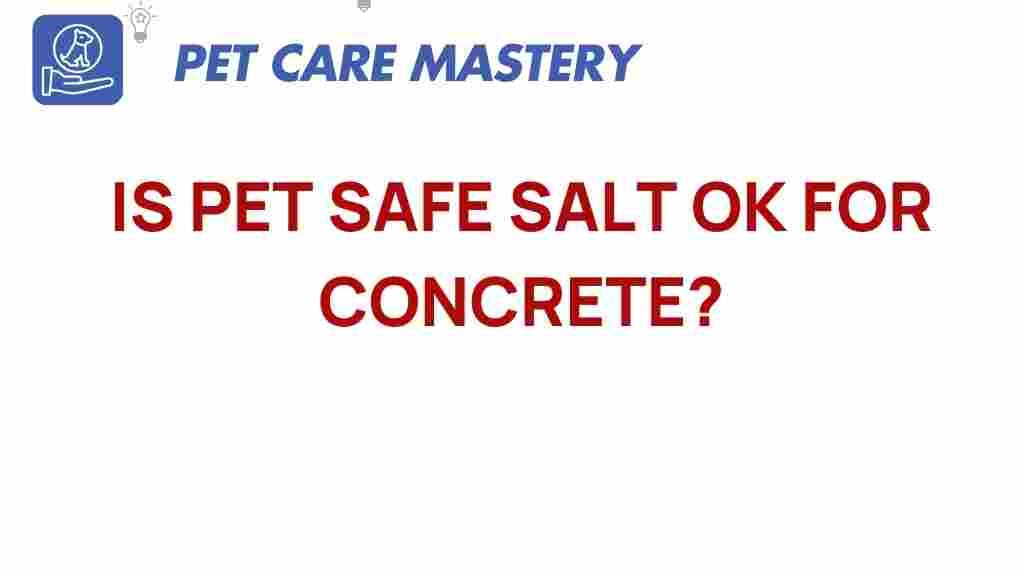Is Pet Safe Salt the Best Choice for Your Concrete Surfaces?
Winter can be a beautiful season, but it also brings challenges like snow and ice accumulation on driveways, sidewalks, and patios. To combat slippery surfaces, many homeowners turn to salt for de-icing. However, if you have pets, you might be wondering if pet safe salt is the best choice for your concrete surfaces. In this article, we will explore what pet safe salt is, its benefits, and whether it truly is the best option for keeping your concrete safe during the winter months.
Understanding Pet Safe Salt
Pet safe salt refers to de-icing products that are formulated to be less harmful to animals than traditional rock salt or other chemical de-icers. Many of these products are made from natural ingredients or have lower concentrations of harmful chemicals. Before we dive into the benefits and disadvantages, let’s look at what these products typically contain:
- Potassium chloride
- Calcium magnesium acetate
- Urea
- Beet juice or other plant-based additives
These ingredients are generally considered safer for pets, but it’s essential to remember that “pet safe” does not mean “pet-proof.” Always supervise pets when they are outside during winter months.
The Benefits of Using Pet Safe Salt
Using pet safe salt offers several advantages, especially for pet owners:
- Reduced Health Risks: Traditional de-icing salts can irritate your pet’s paws and stomach if ingested. Pet safe salt minimizes these risks.
- Concrete Protection: Many pet safe salts are less corrosive than regular salts, which can help protect your concrete surfaces from damage.
- Environmentally Friendly: Some brands use natural ingredients that are less harmful to plants and wildlife.
- Effective in Extreme Conditions: Certain pet safe salts remain effective at lower temperatures compared to traditional salts, making them suitable for harsh winters.
Is Pet Safe Salt Effective for De-Icing?
While pet safe salt has several benefits, its effectiveness can vary based on the product and the weather conditions. Here are some factors to consider:
- Temperature Range: Most pet safe salts are effective down to around 15°F (-9°C). In extremely low temperatures, you might need to reapply more frequently.
- Surface Type: Pet safe salts are designed for various surfaces, including concrete. However, always check the label for compatibility.
- Application Method: Ensure you apply the salt evenly for maximum effectiveness.
How to Use Pet Safe Salt on Concrete Surfaces
Using pet safe salt on your concrete surfaces is relatively straightforward. Here’s a step-by-step guide:
- Check the Weather: Before applying salt, check the weather forecast. Apply salt before a snowfall to prevent ice accumulation.
- Clear the Area: Remove any snow or ice from the surface with a shovel or snow blower.
- Apply Pet Safe Salt: Spread the salt evenly across the affected area. Use a hand-held spreader for larger areas to ensure an even distribution.
- Monitor Conditions: After applying the salt, be sure to keep an eye on the weather and reapply as necessary.
- Clean Up: Once the snow and ice have melted, sweep up any remaining salt to protect your concrete and the environment.
Potential Drawbacks of Pet Safe Salt
While pet safe salt is a great option, there are some potential drawbacks to consider:
- Cost: Pet safe salts can be more expensive than traditional rock salt.
- Effectiveness: In extreme cold, they may require more frequent applications.
- Residue: Some pet safe salts can leave a residue that may need to be cleaned up later.
Pet Safety Tips When Using Salt
Even with pet safe salt, it’s essential to take precautions to keep your pets safe. Here are some tips:
- Wipe Paws: After walks, wipe your pet’s paws with a damp cloth to remove any salt residues.
- Limit Time Outside: Try to keep outdoor exposure to a minimum during harsh weather.
- Monitor for Signs of Irritation: Look out for any signs of discomfort, such as limping or licking paws excessively.
Troubleshooting Common Issues
If you encounter issues while using pet safe salt, here are some common problems and their solutions:
Issue 1: Salt Not Melting Ice
Solution: Ensure you are using the right type of pet safe salt for your climate and check the temperature range on the packaging.
Issue 2: Residue Left on Concrete
Solution: Sweeping the area after the snow has melted can help remove any residue and prevent it from damaging your concrete surfaces.
Issue 3: Pet Shows Signs of Irritation
Solution: Immediately rinse your pet’s paws with warm water and consult a veterinarian if irritation persists.
Conclusion
When it comes to keeping your concrete surfaces safe during winter, pet safe salt is an excellent option for pet owners. It provides effective de-icing while minimizing risks to your furry friends. However, it’s essential to understand its limitations and to use it correctly to achieve the best results. By following the steps outlined in this article and taking the necessary precautions, you can ensure a safe and effective winter season for both your pets and your concrete surfaces.
For more information on pet care and safety, check out this informative guide. If you’re looking for product recommendations, consider visiting this resource for reviews on pet safe salt options.
This article is in the category Products and created by PetCareMastery Team
